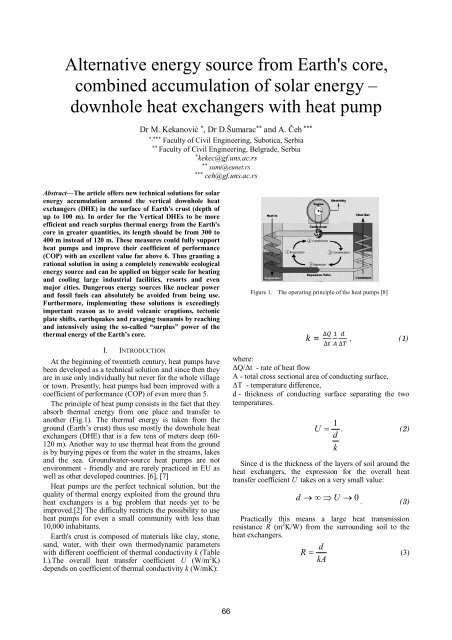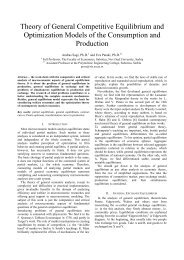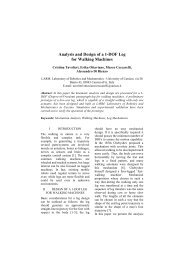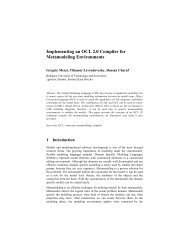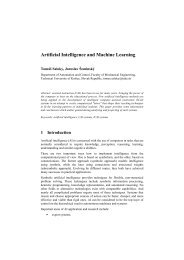Alternative energy source from Earth's core,combined accumulation of solar energy –downhole heat exchangers with heat pumpDr M. Kekanović * , Dr D.Šumarac ** and A. Čeh ****,***Faculty of Civil Engineering, Subotica, Serbia**Faculty of Civil Engineering, Belgrade, Serbia* kekec@gf.uns.ac.rs**sumi@eunet.rs***ceh@gf.uns.ac.rsAbstract—The article offers new technical solutions for solarenergy accumulation around the vertical downhole heatexchangers (DHE) in the surface of Earth's crust (depth ofup to 100 m). In order for the Vertical DHEs to be moreefficient and reach surplus thermal energy from the Earth'score in greater quantities, its length should be from 300 to400 m instead of 120 m. These measures could fully supportheat pumps and improve their coefficient of performance(COP) with an excellent value far above 6. Thus granting arational solution in using a completely renewable ecologicalenergy source and can be applied on bigger scale for heatingand cooling large industrial facilities, resorts and evenmajor cities. Dangerous energy sources like nuclear powerand fossil fuels can absolutely be avoided from being use.Furthermore, implementing these solutions is exceedinglyimportant reason as to avoid volcanic eruptions, tectonicplate shifts, earthquakes and ravaging tsunamis by reachingand intensively using the so-called “surplus” power of thethermal energy of the Earth’s core.I. INTRODUCTIONAt the beginning of twentieth century, heat pumps havebeen developed as a technical solution and since then theyare in use only individually but never for the whole villageor town. Presently, heat pumps had been improved with acoefficient of performance (COP) of even more than 5.The principle of heat pump consists in the fact that theyabsorb thermal energy from one place and transfer toanother (Fig.1). The thermal energy is taken from theground (Earth’s crust) thus use mostly the downhole heatexchangers (DHE) that is a few tens of meters deep (60-120 m). Another way to use thermal heat from the groundis by burying pipes or from the water in the streams, lakesand the sea. Groundwater-source heat pumps are notenvironment - friendly and are rarely practiced in EU aswell as other developed countries. [6], [7]Heat pumps are the perfect technical solution, but thequality of thermal energy exploited from the ground thruheat exchangers is a big problem that needs yet to beimproved.[2] The difficulty restricts the possibility to useheat pumps for even a small community with less than10,000 inhabitants.Earth's crust is composed of materials like clay, stone,sand, water, with their own thermodynamic parameterswith different coefficient of thermal conductivity k (TableI.).The overall heat transfer coefficient U (W/m 2 K)depends on coefficient of thermal conductivity k (W/mK):Figure 1. The operating principle of the heat pumps [8]k = ∆ ∆ ∆ , (1)where:ΔQ/Δt - rate of heat flowA - total cross sectional area of conducting surface,ΔT - temperature difference,d - thickness of conducting surface separating the twotemperatures.U 1 . (2)dkSince d is the thickness of the layers of soil around theheat exchangers, the expression for the overall heattransfer coefficient U takes on a very small value:d U 0. (3)Practically this means a large heat transmissionresistance R (m 2 K/W) from the surrounding soil to theheat exchangers.dR (3)kA66
TABLE I.THE AVERAGE VALUE OF THERMAL CONDUCTIVITY COEFFICIENT FORMOST FREQUENT MATERIALS IN THE EARTH´S CRUSTComponentsCoefficient ofthermal conductivity(k)MaterialClay Sand Stone Water0,8 - 1,3 0,58 - 1,3 1,2 - 3,3 0,83Based on the thermal conductivity coefficient (k) valuesfor the materials in the Earth's crust, in Table I., it can beconcluded that these values are not high and thesematerials in the Earth's crust – in which immersed the heatexchangers of the heat pump – are heat insulating barrierfor the thermal energy of the surrounding environment.Exploiting the heat from the earth is a particularproblem as the geometrical characteristics of DHEs arethin in cross section with a small surface area and arepractically one line in the longitudinal section. In recenttime DHEs are typically made from materials that arepolymer based for better corrosion resistance plus withlower value of thermal conductivity coefficient k and withmeager heat conduction.Thus, during function it often happens that the heat inthe ground around the DHEs is not completely recovered.As a result, in this zone, the temperature falls down, whichalso means a decrease in heat capacity of the heatexchangers (Fig. 2). After a few years it is possible for theDHEs to malfunction.Figure 2. Cooling of the Earth around the heat exchangersAn event from Sweden is a proof in where thetemperature of the soil in the early period of utilizationwas +8 ºC. [3] After twenty seven years of exploitation, adecrease in heat from +8 ºC to +1 ºC was noticed. Everyyear, due to the inactiveness of the ground, through theinsulating properties of the earth manifested by thethermodynamic coefficient of thermal conductivity (k)and the dense installation of DHE, the heat was notrestored completely to its previous degree after the heatingseason. Thus, a fall in the temperature of the Earth of only0,26 ºC was noticed each year and increased to 7 ºC after27 years.Another practical evidence for this claim of heat energyaccumulation is the possibility in the earth is from distanthistory. Romans were digging combustion furnace into theground to a depth of several meters and hot air from thefurnace passes through enclosed areas under floor andinside the walls, after flowed out in the roof – a systemknown as “hypocaust”. At start they had higher heatenergy losses, then later on when the heat were alreadyaccumulated around the fireplace, with a significantlylesser fuel they could hold the temperature inside therooms, and afterwards it would be needed in the casewhen the furnace and the air-flow channels would not beburied. (Fig. 3).Figure 3. Way of heating at the time of ancient Rome with the aim ofaccumulation of heat in the ground around the furnace[11]All of this clearly indicates that the DHEs depth of heatpumps have a number of deficiencies that must beimproved so that the solution could be applicable not onlyindividually but also for the largest cities in the world withmillions of inhabitants:1) DHEs length of 120 m is not enough – but rathershould be at least 300 m length to be able to take excessenergy from the Earth's core.2) Around DHEs in the surface area of Earth's crust (todepths of 100 m), solar energy should be accumulatedusing solar collectors.3) The heat exchangers should be made of metal or amaterial with a dominant share of metal content in thevolume to achieve higher value of coefficient of thermalconductivity (k) and enhanced overall heat transfercoefficient (U)4) Cementing the boreholes around the DHEs should bedone with materials that are hygroscopic and using water(moisture) heat exchange would be fasterII.A NEW TYPE OF DHES AS PASSABLY SUPPORTINGSOLUTION FOR EXPLOITATION OF THERMAL HEAT WITHHEAT PUMPSEarth's core temperature is between 4000 and 7000 0 C.Such high temperature is the result of thermonuclearprocesses initiated during the formation of the Earth itself.Controlled drawing of energy from the Earth's crust couldgive positive effects as more energy is produce than isreleased by layers to the surface in the Earth's core.Preventing the release of heat energy from Earth's corecreates more pressure inside itself. That pressure istransmitted on the layers around the core, which starts totighten and that time comes to form new cracks, usually atthe place of old ones. This particularly occurs in zones of67
- Page 1 and 2:
4 4 th IEEE International Symposium
- Page 3 and 4:
EXPRES 20124 th International Sympo
- Page 5 and 6:
Application of Thermopile Technolog
- Page 7 and 8:
Design of a Solar Hybrid System....
- Page 9 and 10:
___________________________________
- Page 11 and 12:
environmental protection and global
- Page 13 and 14:
But can we use the human body sweat
- Page 15 and 16:
IX. REFERENCES[1] Todorovic B. Cvje
- Page 17 and 18: QQ⎛ Λt⎞=⎜⎟⎝ Λ ⎠Nt Nwh
- Page 19 and 20: Analysis of the Energy-Optimum of H
- Page 21 and 22: V. OBJECTIVE FUNCTIONThe objective
- Page 23 and 24: The Set-Up Geometry of Sun Collecto
- Page 25 and 26: continuous east-west sun collector
- Page 27 and 28: continuously measure the thermal ch
- Page 29 and 30: CEvaluation of measurement resultsA
- Page 31 and 32: Application of Thermopile Technolog
- Page 33 and 34: Temperature of the components [C]90
- Page 35 and 36: nighttime, to weather or to the cha
- Page 37 and 38: η uη u0.50.40.30.20.1T 1 - 400K0.
- Page 39 and 40: Figure 10. . SPS Concept illustrati
- Page 41 and 42: [16] Zoya B. Popović: Wireless Pow
- Page 43 and 44: 25.0020.0015.0010.005.000.00Figure
- Page 45 and 46: · ℃ 0.0738 · 1.209 0.0892
- Page 47 and 48: use may be advantageous not only in
- Page 49 and 50: To find the reasons for this disagr
- Page 51 and 52: Toward Future: Positive Net-Energy
- Page 53 and 54: EnergyPlus environment, we used mod
- Page 55 and 56: To keep future energy consumption d
- Page 57 and 58: A New Calculation Method to Analyse
- Page 59 and 60: On Fig. 3. can be seen the areas th
- Page 61 and 62: Present and Future of Geothermal En
- Page 63 and 64: TABLE II.THE TEMPERATURE DATA AND C
- Page 65 and 66: Error in Water Meter Measuring at W
- Page 67: III.RESULTS OF MEASURMENTSEach meas
- Page 71 and 72: If the walls of the DHEs are made o
- Page 73 and 74: Environmental External Costs Associ
- Page 75 and 76: iodiesel production facility with a
- Page 77 and 78: Contribution of unit processesto ex
- Page 79 and 80: Heat Pump News in HungaryBéla Ád
- Page 81 and 82: Thermal Comfort Measurements In Lar
- Page 83 and 84: IV.DISCUSSIONThe sample frequencies
- Page 85 and 86: For a Clear View of Traditional and
- Page 87 and 88: esults in geographically distribute
- Page 89 and 90: Design of a Solar Hybrid SystemMari
- Page 91 and 92: Maintaining the set point temperatu
- Page 93 and 94: Decision system theory model of ope
- Page 95 and 96: parameter of pump in the function o
- Page 97 and 98: Importance and Value of Predictive
- Page 99 and 100: D. Overview of existing boiler oper
- Page 101 and 102: HEAVY FUEL OIL FIRED, STEAMNATURAL
- Page 103 and 104: MATHEMATICAL MODEL AND NUMERICAL SI
- Page 105 and 106: C. Energy balance equationMathemati
- Page 107 and 108: Discretization energy balance equat
- Page 109 and 110: T ulf=32 º C, A - m =0.00162 kg/s,
- Page 111 and 112: Comparison of Heat Pump and MicroCH
- Page 113 and 114: the microCHP development. The energ
- Page 115 and 116: control and stabilizer must be deve
- Page 117 and 118: In Figure 1, in relation to the ord
- Page 119 and 120:
NPCC BHXOBYNI x1I x2I x3I x4LO YKYO
- Page 121 and 122:
exchange, as in reality, economies
- Page 123 and 124:
esponsibilities for consequences, o
- Page 125 and 126:
Coca-Cola Enterprise Inc had approx
- Page 127 and 128:
Flow Pattern Map for In Tube Evapor
- Page 129 and 130:
circumference with a liquid film. T
- Page 131 and 132:
Tube diameter: d 6 mm W Heat flux
- Page 133 and 134:
Realization of Concurrent Programmi
- Page 135 and 136:
applications the development, optim
- Page 137 and 138:
Renewable energy sources in automob
- Page 139 and 140:
commercial arrays can be built at b
- Page 141 and 142:
of multiple thin films produced usi
- Page 143:
EXPRES 20124 th International Sympo


